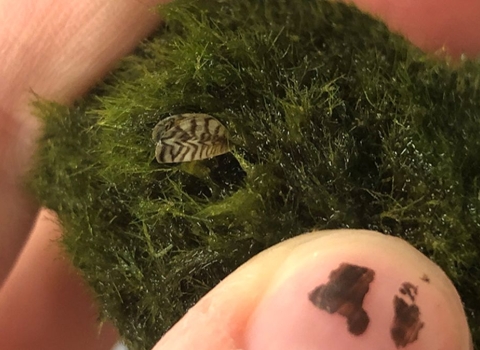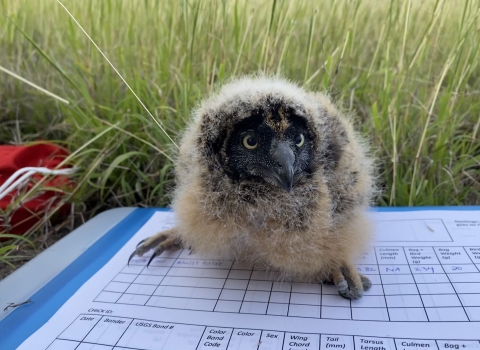Invasive zebra mussels have been found in Marimo moss balls, a plant product sold at aquarium and pet supply stores, garden centers, florist shops, and online retailers. Zebra mussels are regarded as one of the most destructive invasive species invasive species
An invasive species is any plant or animal that has spread or been introduced into a new area where they are, or could, cause harm to the environment, economy, or human, animal, or plant health. Their unwelcome presence can destroy ecosystems and cost millions of dollars.
Learn more about invasive species in North America and there is concern that live mussels from moss balls could be released into a storm drain or flushed into a waterway and cause significant damage.
On March 2, 2021, the U.S. Geological Survey (USGS) confirmed a report from a Seattle pet store of zebra mussels attached and inside moss balls. Additional investigation revealed that numerous pet stores across the country also received contaminated moss balls. As of April 27, 2021, zebra mussel contaminated moss balls were discovered in 46 states. This discovery initiated an international response involving state, provincial, and federal agencies, Tribes, non-governmental organizations, and industry. The U.S. Fish and Wildlife Service coordinated with these partners with the goal to:
- Stop the importation of zebra mussel contaminated moss ball products into the United States; and
- Properly dispose of contaminated moss ball products already in the U.S. supply chain, retail stores, online commerce, and home aquariums and water gardens.
Since 2021, federal agency partners have been working together to address importation of plant material shipments that may unintentionally have injurious species attached, or within, those shipments. Efforts were successful in their ability to stop the sale of moss balls and quickly remove zebra mussel infested moss balls from the retail store shelves. To the best of our knowledge, no zebra mussels introductions into a waterbody occurred as a result of this incident.
You can help protect our Nation's waters from invasive mussels!
If you have recently purchased Marimo moss balls from any retailer, you should inspect them for zebra mussels. If there is any sign of invasive mussels, decontaminate and destroy them using the guidance below. Reports of zebra mussels attached to moss balls should also be reported to your state natural resource agency and submitted to the USGS Nonindigenous Aquatic Species database.
Never dispose contaminated moss balls in drains, waterways, or gardens. Moss balls must be destroyed and disposed of in a sealed container in the trash.
You can also help by buying responsibly online:
- Before purchasing Marimo moss ball online, contact the seller and verify the origin of the moss balls.
- Know the laws! - Several states restrict or prohibit the sale of moss balls, for questions or concerns specific to your state, reach out to your local fish and wildlife agency.
- Never purchase Marimo moss balls from a foreign retailer! Any shipment of moss balls must meet permitting requirements and undergo inspection at a U.S Department of Agriculture Plant Inspection Station. If you think something was illegally imported — even if unintentionally — contact the confidential Antismuggling Hotline number at 1-800-877-3835 or SITC.Mail@usda.gov
If you have any questions regarding zebra mussels and the safe disposal of moss balls, please contact us.
Moss Ball Decontamination Instructions: Destroy, Dispose, Drain
When following any of the methods listed below, ensure that the disposal method you choose is in compliance with your local state laws and animal welfare regulations.
A more detailed list of DESTROY, DISPOSE, DRAIN instructions can be found here. (Last reviewed 08/10/2024)
DESTROY in one of three ways:
- Freeze - Place the moss ball into a sealable plastic bag and freeze for at least 24 hours.
- Boil - Place the moss ball in boiling water for at least 1 full minute.
- Bleach / Vinegar - Submerge the moss ball in regular, unscented bleach, diluted to ⅓ cup per gallon of water, for 10 minutes; or undiluted white vinegar for 20 minutes.
DISPOSE of the moss ball and any of its packaging in a sealed plastic bag in the trash. If vinegar, boiling water, or bleach was used, the liquid can be disposed down a household drain —never down a storm drain where it could enter and damage local waterways.
DRAIN and DECONTAMINATE
For aquariums: Collect any fish or other living organisms and place them in another container, with water from a separate, uncontaminated water source. Remove contaminated water from the tank and sterilize by adding ⅓ cup of bleach for each gallon of water. Let the water sit for 10 minutes and then dispose the sterilized water down a household drain.
Clean the aquarium and accessories using ONE of the following methods, ensuring that the decontaminate method you choose is in accordance with manufacturers’ recommendations:
- Hot Water Method:
- Use water that is 120°F to flush and coat the tank and all accessory surfaces for at least two minutes.
- Salt Water Method:
- Make a saline solution using ½ cup of salt per gallon of water and soak aquarium substrate, rocks, décor, and filter media in salt water solution for at least 24 hours.
- Dispose of the treated water in a household drain and rinse all items prior to setting up the aquarium.
- Bleach Disinfection Method:
- Make a disinfection solution using ⅓ cup of bleach per gallon of water.
- Soak the aquarium, substrate, rocks, décor, and filter media in the bleach water solution for 10 minutes.
- Rinse off all items prior to setting up the aquarium.
- Dispose of the previously used filter media and replace with new media.
- Use a dechlorinating product to neutralize any residual chlorine prior to reintroducing aquatic life.
For water gardens or larger aquariums, a Potassium Chloride (KCl) method can be used. It is considered safe for most finfish and plants; however, it may not be safe for invertebrates.
- Determine the volume of water in your system and the corresponding amount of KCl required to achieve a concentration of 100ppm (a table is provided in the protocol).
- Maintain the required treatment concentration for a period of at least 14 days at a minimum temperature of 65°F.
- Decontaminate any submerged accessories and equipment used to remove water or organisms from the system using either the hot water, salt water, or bleach methods listed above.
Frequently Asked Questions
The moss balls found to be contaminated with zebra mussels are known as Marimo moss balls and are not composed of moss, but a green algae (Aegagropila linnaei) that is formed into a ball and is 2 to 5 inches in diameter. Moss balls are used in home aquariums, terrariums, and water gardens. Before the discovery of the mussel contamination, these moss balls could be purchased in every state (except Hawaii) through national retail chains, small independent retailers, and online marketplaces.
The species is found mainly in areas of Northern Europe and in several places in Japan. It has rarely been found in North America and Australia. The moss ball itself is not found to be invasive.
Are all moss balls sold in stores made of filamentous algae?
No. Other moss balls sold in aquarium stores may be true mosses, such as Java moss (Vesicularia dubyana). The U.S. Fish and Wildlife Service is not aware of zebra mussel introduction risks occurring with this species of moss. Artificial plastic moss balls are also commonly sold in retail stores and online and should not have a risk of transporting zebra mussels.
What are zebra mussels, and why should we be concerned that they are being found in moss balls?
Zebra mussels (Dreissena polymorpha) are one of the most devastating invasive species in North America. They are a fingernail-sized freshwater mollusk native to the Black, Caspian, and Azov Seas of Eastern Europe. Zebra mussels can reach extremely high densities and quickly take over a waterbody once they become established, causing significant environmental and economic damage. Impacts may include
- disrupting the food chain;
- smothering native mussels;
- changing the water chemistry, which can cause more blue green algae outbreaks or offensive taste;
- clogging water intake structures, delivery systems, and other infrastructure; and
- littering beaches with sharp shells.
A significant concern is that live mussels carried by the moss balls may escape or be released into a waterway. Although zebra mussels have already become established in numerous waterbodies, there are still many uninfested waters throughout the United States that need protection.
Are moss balls sold online free from zebra mussels?
The U.S. Fish and Wildlife Service is aware that Marimo moss balls are available to purchase on several online sites. Some of these sites may claim that the moss balls have been lab-tested to be free of zebra mussels or have been certified as “free of any living zebra mussels.” These statements are false and misleading. Any shipment of moss balls arriving into the United States must have an import permit, a phytosanitary certification, and is subject to inspection by the U.S. Department of Agriculture. Zebra mussels are listed as injurious wildlife and are prohibited from importation into the United States. As such, any shipments found to contain zebra mussels are referred to the U.S. Fish and Wildlife Service where they are subject to enforcement actions, including but not limited to, seizure of the shipment.
Can I just quarantine my moss ball for a few months rather than destroy it?
Zebra mussel larva are very small and often can’t be seen by the naked eye. They can live in the water, aquarium substrate, and decorative elements in your tank and can damage filter systems. It is understood, however, that many aquarists and water gardeners make significant investments in establishing and maintaining their systems and that discarding the water and reestablishing a system in which mussels have not been observed may not be ideal. As an alternative, and consistent with steps necessary to prevent the release of zebra mussels, aquarists and water gardeners may follow a quarantine method. Please refer to the link above for detailed instructions.
How do I report zebra mussels found in moss balls?
Reports of zebra mussels attached to moss balls should be submitted to the USGS Nonindigenous Aquatic Species database. Upon submission, the information you provide is sent to USGS staff experts for verification. If you find zebra mussels, follow the Destroy, Dispose, Drain procedures outlined above. For questions or concerns specific to your state, reach out to your local fish and wildlife agency.






